Ciara Phillips and the intersection of art, labour and gender
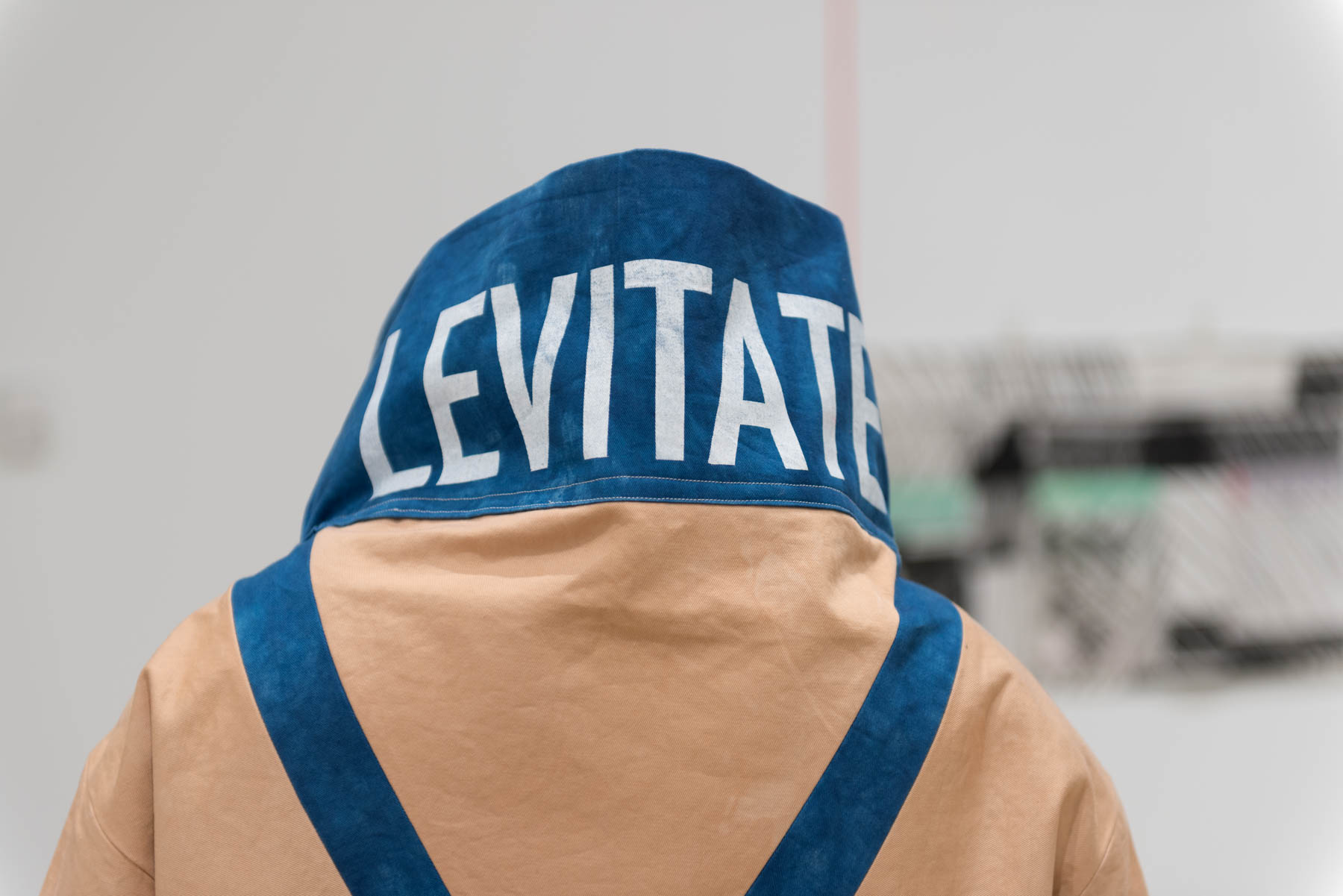
Comrade Objects: Ciara Phillips marks the Glasgow-based Canadian artist’s first solo exhibition in Canada. Framing the exhibition is the spectre of Russian Constructivism, an avant-garde movement beginning in 1913 that rejected art-as-autonomous for art-as-social and art-as-political. In Comrade Objects, the politics and aesthetics of the everyday find resonance in garments and screen-prints, photographs of the artist’s home and studio, and photographs of her female friends engaging in the lesser acknowledged activities associated with creative work. The gallery, divided into the main exhibition space and a participatory, process-based workshop space, becomes a site to reflect on the labour of art, politics, gender and everyday life.
In the center of the main exhibition space are five dress-forms donning textile pieces — garments made by the artist. They stand along the length of three pieces of wood assembled on the gallery floor in a form intimating the symbol for nuclear disarmament without the exact symmetry or the enclosing circle. This symbol returns in the workshop component of the exhibition with Phillips and her collaborator, Clive Robertson, representing it with their bodies in performative photographs. The walls of the main exhibition space form a grid, the white gallery walls forming white boxes with the intervention of orange-red horizontal and vertical lines.
The formal and thematic invocation of early 20th Century histories exist alongside the contemporary in a manner that is not uncommon in Phillips’ practice. The aesthetics of Russian Constructivism are made new with materials from the artist’s own context, with references to Brexit and text in collage reading “Free/hot/mess.” The garments themselves look like something I might find in a fashion and design store today, pieces that could as readily be worn now as they could in 1913. Fashion becomes an interesting entrance point for an exhibition that is taking up the politics and aesthetics of our relationships to objects in light of the 20th Century’s tensions between communism and capitalism. The pockets are at once decorative and utilitarian, receptacles for texts that are politically meaningful. Phillips seems to be straddling this ambivalence between the practical and the decorative, the utilitarian and the superfluous, the aesthetic and the political (as if the two could be divided). Her use of colour is deliciously unfamiliar. The works in this show seem to draw as much from Russian Constructivism as from Pop art and feminist histories of performance, photography and screen-printing.
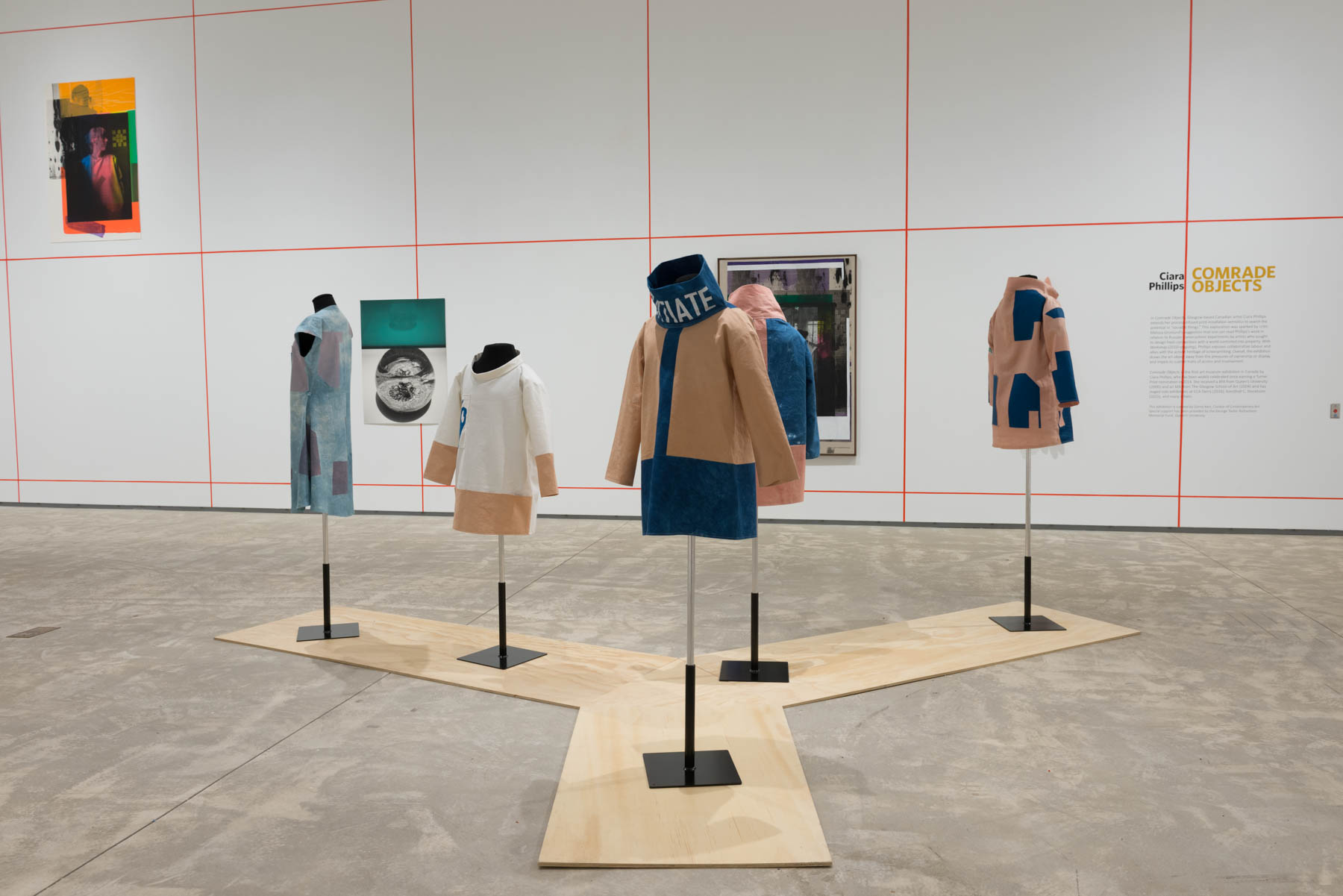
Moving into the Workshop space, we find two of Phillips’ framed alphabet screen-prints forming the word “NO.” The “N” and “O” are coloured pink, yellow, blue and green on a background of streaky black; the colours are a kind of queering of the rainbow that we also find in the screen-prints in the main gallery. The “N” is formally faltering, imperfect in its lack of straight lines, its lack of symmetry that we expect to find in this letter. There is a feminist resonance in this “NO” with the ongoing politics of consent (“no means no”) and the feminist politics of refusal (to smile, to obey oppressive patriarchal social strictures). I also think of the politics of women saying “no,” particularly when it comes to unpaid labour, precarity and time. In this workshop space, viewers bear witness to the process of collaboration between Phillips and Robertson, as the artists converse through the sharing of images and text on the large bulletin boards. With its participatory screen-printing and Xeroxing, this space is similar to other recent feminist installations, like Hazel Meyer and Cait McKinney’s use of digitizing and scanning stations in their collaborative exhibition Tape condition: degraded that recently closed at the Canadian Lesbian and Gay Archives. This process-based, collaborative approach to making, combined with an upholding of the politicized histories of these practices (screen-printing, for example) seems to be an important aspect of this contemporary feminist work.
Lauren Fournier connected with Phillips over Skype in September 2016 to talk about Comrade Objects.
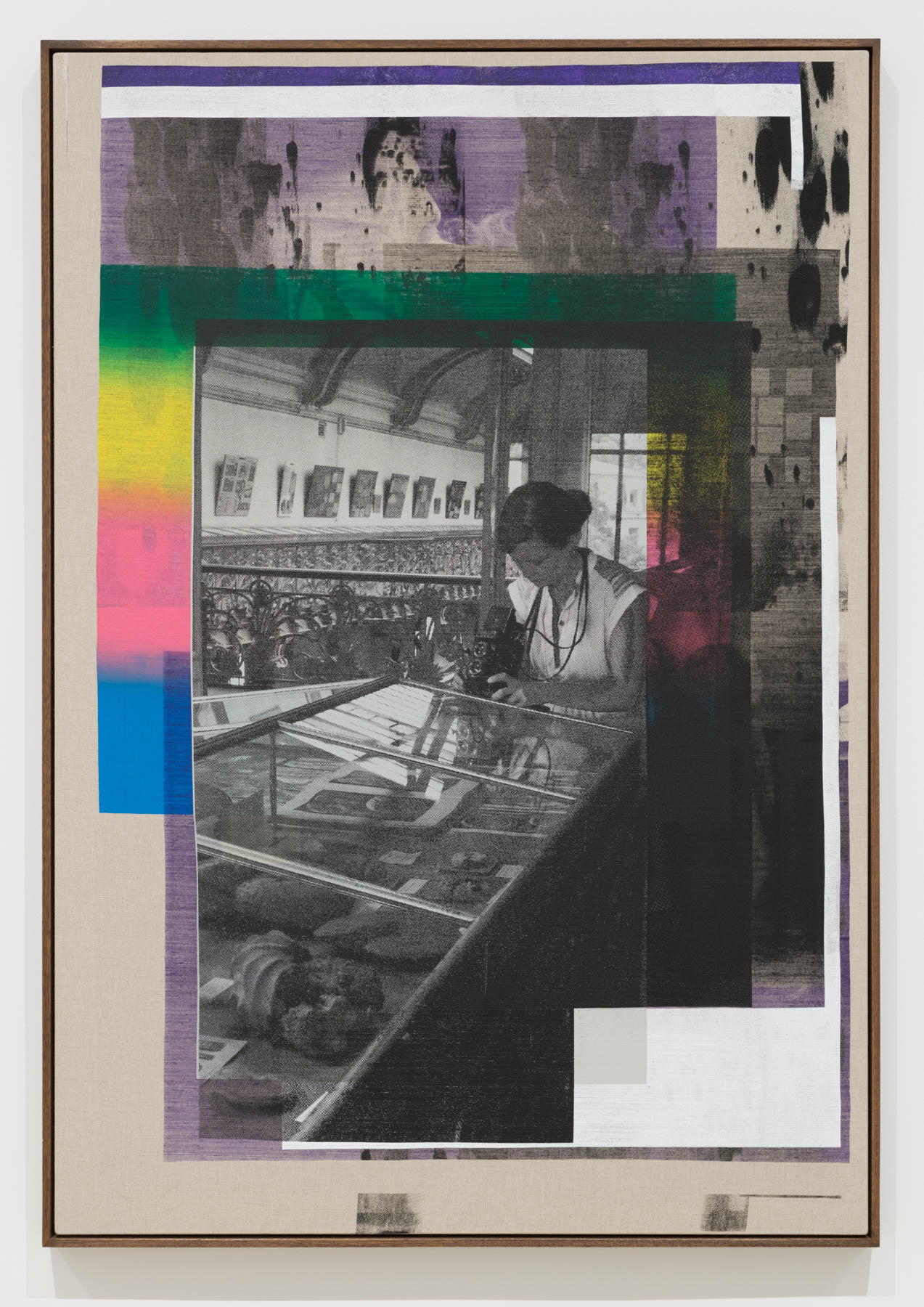
Lauren Fournier (LF): How did the Comrade Objects show come about?
Ciara Phillips (CP): Through an invitation from the curator of contemporary art, Sunny Kerr. He was particularly interested in my workshop project approach to exhibitions that began in 2010 where I am in situ in the gallery for a period of the show and invite other people in to work with me. This show is in two parts: the main exhibition space has an installation of mostly recent works including some older screen-prints. There are a number of garments in the centre of the space, which nods to the history of Constructivist making. They are artist smocks that I have adapted and made new: I have dyed and printed the fabric, making them into these tunics. One of the tunics has a pocket in the front with a copy of the Financial Times on the Brexit crisis sticking out of the top, and a patch on the arm that reads “Demonstrate”: I made that when I was really angry about what was going on. Another one is a dress with a front pocket that reads 2016 and the book The Hermit by my friend Lucy Ives in it. There is another new work on the wall that is a big long canvas piece with pockets and hand-printed books that you can take out of the pockets to look at.
LF: The title of your exhibition invokes 20th Century histories of communism, socialism and the politics of labour. It is also interesting to me that the word “Comrade” was often used synonymously with brother, a kind of fraternal bonding and identification within Communist and Socialist collectives. Women might have been excluded in this category of “comrades,” something you seem to subvert in your foregrounding of images of women working.
CP: These are my comrades — female artists, writers and designers. There are three images of women within the show. The title came from an essay written about my work by Melissa Gronlund, who was looking for a way to bring together the process-based aspect of my work, in the workshops, and how process is made visible through the works that I make on my own — in layering, for example — me making a garment that is printed, taking a photograph of a friend wearing it, and then making that into a print. I didn’t know that the Constructivists had been thinking about making a relationship with the object and thinking of the object as like a co-worker: I found this to be a really interesting idea. They were thinking about having a more sympathetic relationship with the things that they made, and what are our relationship is as makers to the objects we make that is something different from possession, which tends to be the main way of relating to objects in capitalism. I really like that Gronlund brought that to a reading of my work. With the show at Agnes Etherington, Gronlund’s essay gave me a framework for choosing the works: it is more like “comrades and objects.” I picked out, from previous shows, some photographic screenprints of objects that occupy my everyday. So, for example, an image of my kitchen light taken from below and a water-bottle sitting in my studio. Those objects have served in exhibitions in different ways that were not necessarily about objects but about reflective moments, a pause or a quiet moment in the show. Thinking about “comrade objects” helped me to pull that out.
LF: I think of the recent turn to object-oriented ontology and the agency of objects. Or, being grounded in this socialist and Marxist history I think of Marx’s critique of the alienation of labour in which we do not have a relationship with the objects that we produce; in your show, alternatively, the relationships you have with these objects are foregrounded.
CP: Yeah, I think artists can have a fraught relationship with the things that they produce. For me, I like working with material, I like working with things. I use that as a way of thinking through ideas, and I think that the objects hold thoughts within them about the things that I care about. Yet once they are made and once they become exhibited they enter into the world of capitalism and then …[laughs] … they can get out of your control altogether! I think it’s nicer to think about them as friends, coworkers.
LF: Yeah, it’s like it is this baby that you have created and put into the world.
CP: [Laughs] Yeah.
LF: This brings me to my next question. In your work, I perceive resonances with feminism, both historic and current. Your images of women working, your use of slogans and text like “EVERY WOMAN A SIGNAL TOWER.” In what ways is your practice a feminist one? I ask this, aware that some artists are resistant to the feminist label.
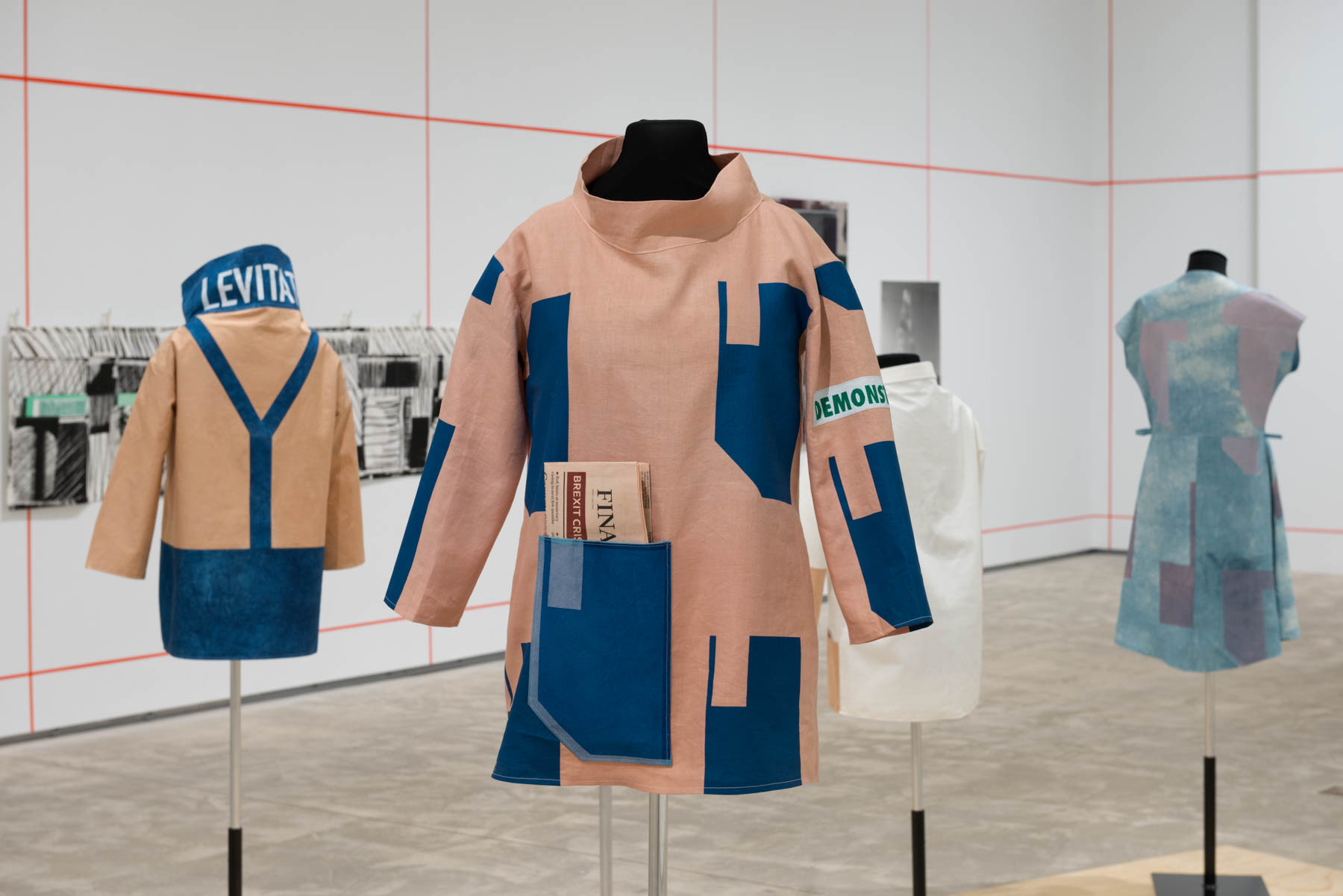
CP: I definitely don’t feel resistant to that label. I think feminism is embedded within how I work and what I choose to represent in the work. I don’t explicitly talk about it very often, but I think it is there. Maybe it is coming to the fore more, the older I get. My ship project [Every Woman: Dazzle Ship Scotland, 2016] is explicitly a feminist piece of work. It was about drawing attention to these lesser discussed histories of women’s role within WWI; this was particularly about young female art students whose efforts had been employed for the purpose of dazzling ships, but not much has been said about their contribution.
LF: You seem interested in engaging with history in your practice, particularly war-time histories. The black-and-white photographs in the collaged screen-prints of women working, for example, have a war-time feel. I think of Corin Looking, for example.
CP: All of the photographs that I use within my work I have taken myself. Corin Looking is a friend who is an artist in the Natural History Museum in Paris who is taking a photograph with an old camera. It has a feeling of being from another time but was taken in 2011. Another image in the show is my friend Laura wearing a garment that I made and standing in the Glasgow School of Art. When I took that image, I was thinking of young female art students in Glasgow in the early 20th Century. So, the feeling coming from them is speaking to those histories, but it is important to me that they are contemporary images and that I draw from now.
LF: Like re-staging, or re-iterating…
CP: …or just allowing to be present. Maybe the Laura picture is a kind of re-staging. The Corin wasn’t intentionally so. I see those histories in the work and allow them to be there. The third image, Emily Reading, is much more clearly contemporary: a friend sitting with her laptop and an empty baby chair behind her — it is a moment when she had 20 minutes to do her work. With the titles of these works, I want to get at how these activities are work, how they are an important part of the creative process.
LF: The work in this exhibition seems explicitly political. In the heyday of modernist formalism, there was this resistance to explicitly politicized work — as if you could not be valued as formally innovative and have politics to your work. I noticed the series Justice For Domestic Workers Alphabet on the Agnes Etherington website for your current show. Could you talk a bit about this series? Visually, there is this connection to a modernist formalism and then mixing contemporary politics, which I find evocative.
CP: Those images are on the Agnes website but that series is not actually in the show. But, there is a connection to the show that they were involved in. When I do the workshop component of each exhibition, I choose who I would like to get involved, depending on the context of the institution. I worked with Justice For Domestic Workers in London in 2013 when I was invited by the Showroom, which is a gallery that makes a real effort to have connections with local groups. They have worked with Justice For Domestic Workers on a number of artists projects and, interestingly, Justice For Domestic Workers initially came to them rather than the other way around. So, the gallery asked me if I would be interested in doing something with Justice For Domestic Workers and I said yes.
I looked at the ways in which they chose to represent themselves publicly, and much of that was holding up banners, photographing themselves, posting them online, and attending rallies and marches. My suggestion was we would make an alphabet and devise new slogans together. A group of 20 women got together and they made the alphabet in three hours. They looked really incredible. We talked about the different slogans that they had used in the past and one I found particularly powerful was “NO TO SLAVERY,” so I suggested we make a banner that read that, with Justice For Domestic Workers printed on the other side. So, that combined my skills in screen-printing and their messaging. They took the banner with them, out of the gallery space, and wrote back to me saying, listen, because we have the most colourful banner we always get out photograph taken when we go to things. There is something that the aesthetic level of the work enabled to happen that I hadn’t anticipated. It felt to me like a pretty good meeting of their work and my work.
LF: It’s like it becomes effective advertising, which is interesting when we think of the historical connection of slogans to advertising. What is the nature of the workshop component of your current show at the Agnes Etherington?
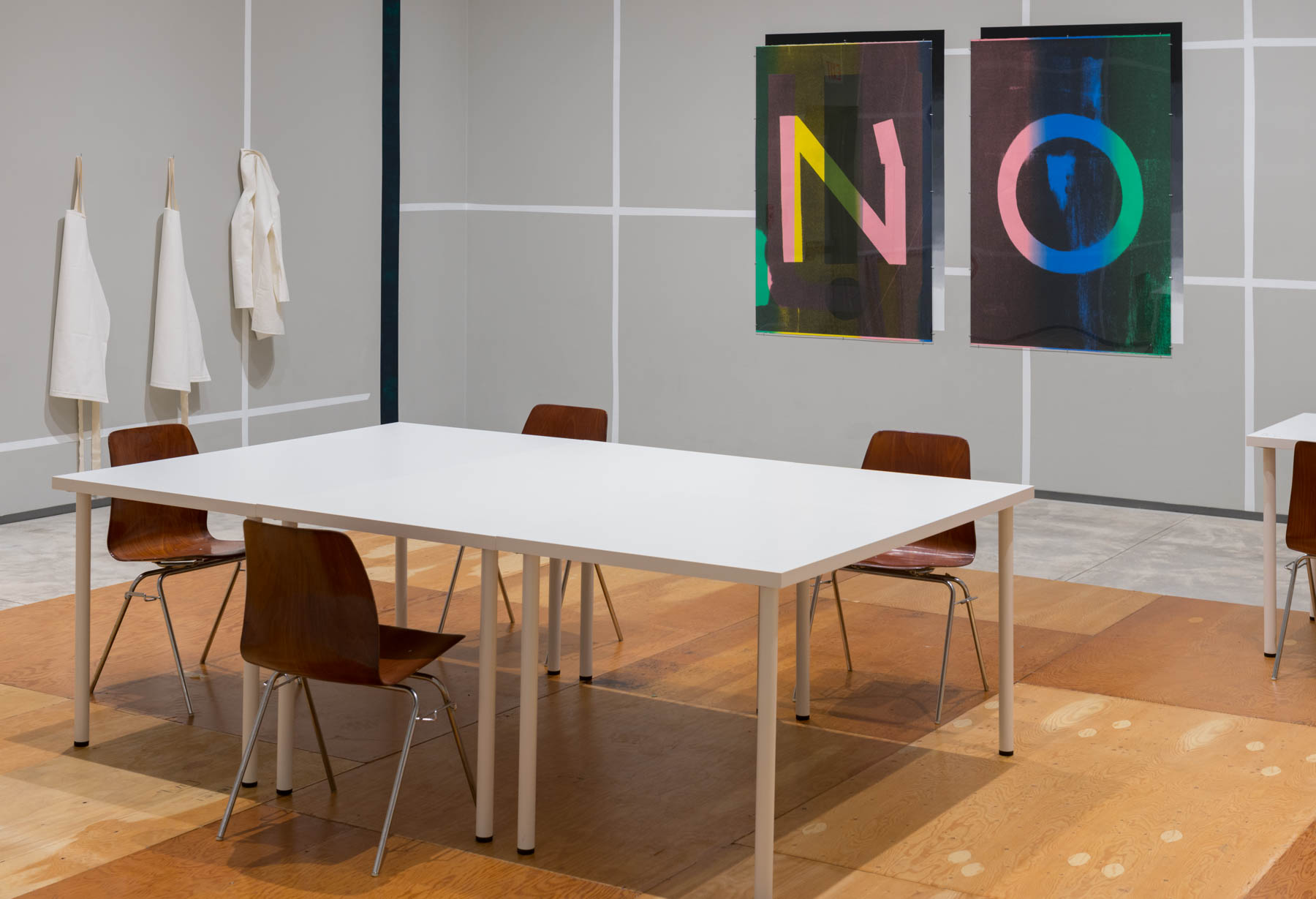
CP: It is similar in that it is a simple set-up for screen-printing and photocopying. I was a student at Queens, so I thought that is what is particular in this environment for me. I decided to invite one of my former professors, artist Clive Robertson. I have always admired his interest in campaigning for artist’s rights, and I asked if he would like to come and work with me. He is really funny and he came in and asked, “Do you realize both of our surnames are screwdriver heads?” And, I said, “No.” And then, we started talking about semaphore, and my use of semaphore in relation to women’s bodies, and then ships, Morse code. And he said, “Did you know that the symbol for the campaign for nuclear disarmament — the ban the bomb, peace sign — comes from semaphore?” My response: “Yes I did, I came across that in my research recently.” So, the letter N involves a person standing with their arm like that — outstretched — and we brought these two ideas together, the Phillips and Robertson screwheads and the symbol for nuclear disarmament, and we staged photographs of ourselves at the edge of Lake Ontario, signalling.
LF: Where will we be able to see these images?
CP: They are up in the gallery as part of the show. The workshop space has a huge corkboard in it with all of these thoughts that Clive and I have been sharing, which is getting very full.
LF: I also noticed the workshop co-presented with Modern Fuel Artist-Run Centre on “Your Own Grad School Open Study Session.” What is this about — grad school, autonomy, agency, the economics of grad school, contemporary precarity politics?
CP: Yeah. I had them in [on Tuesday, September 20]. They were supposed to come for one session but it went so well that they are coming back next week. I have always been interested in educational alternatives.
LF: I wasn’t familiar with their work, but now I am intrigued — as someone in my, what, seventh year of grad school.
CP: [Laughs] At York?
LF: Yes. I’m curious as there was an article recently published in Canadian Art about Canadian artists who leave Canada and work in other cities, like Berlin. And, there is this more cynical view that, in order for a Canadian artist to be recognized within Canada, they need to be based internationally.
CP: Do you think that’s true?
LF: I don’t know. I don’t think so. But, as an artist originally from Canada who has been based in the U.K. for a while now— and is returning to show in Canada— what are your thoughts on this? Does being a “Canadian artist” shape your artistic identity or your practice? What does it mean for you to be a “Glasgow-based Canadian artist”?
CP: I did my BFA in Canada and I am half Irish, so I decided to go either to the U.K. or Ireland to do my MFA. I never really intended to end up living there for an extended period of time but Glasgow is really great. It’s a great city. It is affordable to live there, there is a lot going on. It wasn’t really until the Turner Prize nomination [in 2014] that Canada got in touch. [Laughs] That seemed to have the effect of alerting Canada to the fact that I am Canadian. I have had many invitations to come back as a result. The nice thing about being invited back is it is a way of being here for a longer length of time and to spend some time here. I’m wondering if it is the same in Scotland. A lot of artists stay in Scotland, but it’s so different geographically. Canada is so big, there are a lot of institutions to show in, and there is good support from the Canada Council as far as I can tell. But, that’s an interesting idea — that you have to go away to get recognition in Canada.
Ciara Phillips’ exhibition Comrade Objects runs at the Agnes Etherington Art Centre at Queen’s University in Kingston, Ontario until December 4, 2016.
Lauren Fournier is a writer, artist and PhD candidate based in Toronto. Her writing has been published in Canadian Art, West Coast Line, the Journal for Comparative Media Art and KAPSULA.



